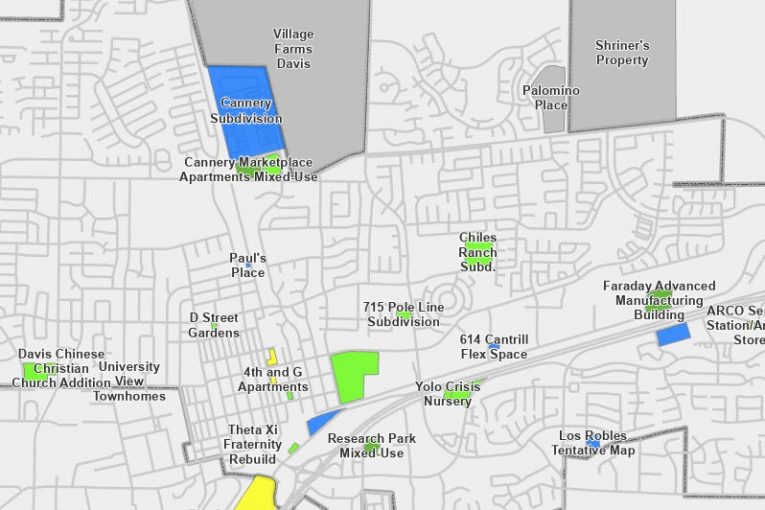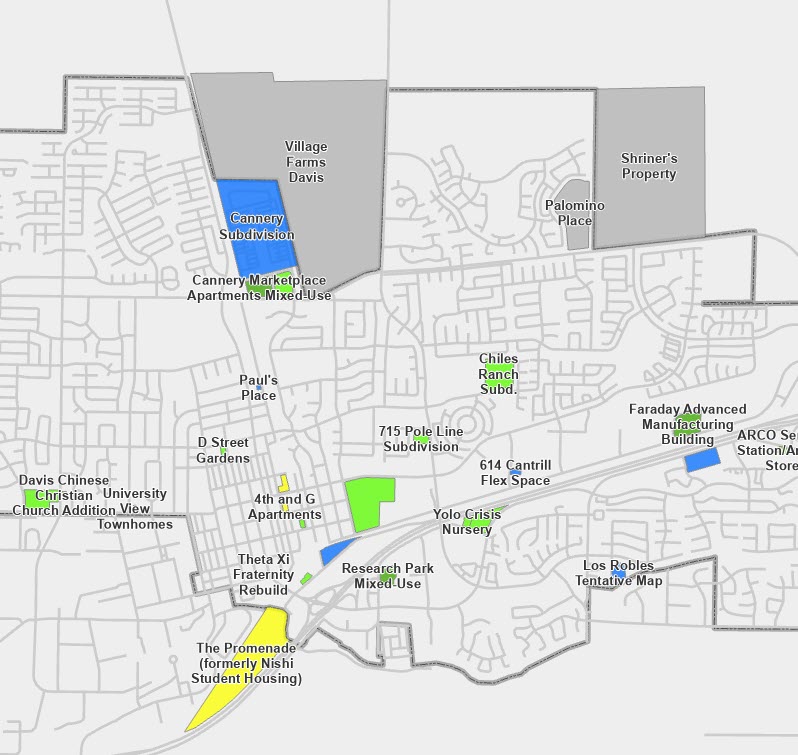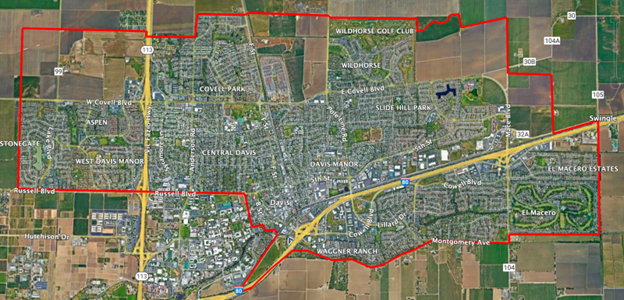

By David M. Greenwald
Executive Editor
Davis, CA – For decades in Davis, the debate was between slow growth/no growth and pro-growth camps (although that division is a bit simplistic). But in the last few months, that debate has shifted.
Last night there was a very interesting side debate—both on the dais and elsewhere—it was a “more deliberative planning” versus “just do something now” camp.
And while the “just do something now” camp, of which I am a proud member, won out on the dais, I think the planners have some really strong points.
Frankly, it is refreshing. I think most people understand that we need housing. The debate is now over how much, when, and how/what type. That’s a much more healthy conversation for the community.
Why am I in the “just do something now” camp?
I take the long view. A decade ago, it seemed that everything was lining up to do focused economic development. We had a Chief Innovation Officer, we had community discussions, we had the Innovation Park Task Force, the Studio 30 Report, DSIDE, Davis Roots, Jumpstart Davis—and we had several project proposals come forward. And slowly but surely all momentum was lost, then three either failed Measure J votes or just faded away. Now innovation park development in Davis is now largely dead without a significant change in direction.
So the idea that we can afford to take our time, and do a planning process, I fear could result in similar collapses.
There are some key differences for sure—a statewide housing crisis, the state breathing down our necks—but that apparent momentum could dry up very quickly.
The second problem—can you even do good planning with Measure J? The city manager yesterday put forward the idea of a Specific Plan for Northeast Davis.
It was a truly great idea. But there is a problem, as City Manager Mike Webb explained: “To be a true specific plan, that it would be a plan that the City Council would adopt and to adopt it and have general plan land of designations be effective. Those would be subject to first going to the voters.”
Councilmember Gloria Partida pointed out that “if we don’t do a full specific plan and have to do the EIR and have to go to Measure J/R/D vote, that’s a huge gamble because it may not pass. It more than likely won’t pass, because people won’t know what’s going to go there.”
She then added, “I think that people would be very skeptical about that. I don’t know that it would pass, we’d spend a lot of time and money and then still have to go through another J/R/D vote when the individual projects came in.”
That seemed to capture the concerns of the council on the Specific Plan.
Vaitla added, “Gloria, I mean, I agree with you that even as a standalone ballot measure, that’s a very tough thing to win for the reasons that you said it’s, people don’t know specifically what’s going there, et cetera.”
And that’s the problem. If you want truly good planning, you have to be able to … plan. And there is always a barrier to that… Measure J/R/D.
I think if you truly want good planning, you have to get rid of Measure J/R/D. OTHERWISE… you have to play politics.
I still favor a modified Measure J/R/D over getting rid of it, but I am pointing out that as long as Measure J/R/D is around, you have to take a political view of the world. You have to put forward projects that can win and when they can win.
If good planning means density, then Measure J/R/D is going to be a huge barrier to density. (We are already seeing objections to the proposed downtown projects over density and parking.)
“CEQA sees added density as being added impacts,” Arnold explained. “The same has also been the case for the voters of Davis.”
He explained, “If you’ve ever looked at a lawn sign that is “no” on whatever proposal is in front of us, almost all of them have a picture of a car in gridlock. That’s almost always the number one argument. There’s what we can achieve in density in a perfect world. And there’s, what are the voters of Davis going to accept.”
Good planning might be 1800 or even more units at Village Farms, but that means traffic impacts and that will create a ready-made campaign that could very well defeat the project.
Measure J/R/D also means timing matters.
Why do I keep pushing for November 2024? Because that is going to be a high turnout election, with tons of students who are likely to support housing.
You go to a special election in 2025, you are going to get pretty much the core voters only, and those core voters tend to be slower growth people. We can see that in the difference between the 2020 and 2022 votes on DiSC.
You might get a project approved in 2025 given everything, but it’s not going to be a “good planning project.”
As long as we have Measure J/R/D as currently written, politics matters more than “good planning.”
Look, I’m not opposed to good planning—I would love to have a robust General Planning, community engagement, lots of affordable housing—but we have to put projects forward that can pass Measure J/R/D votes and that builders can actually build.
Community Development Director Sherri Metzker really captured the dilemma here really well.
She said, “I would’ve envisioned whether we had these projects pending or not, that one of the issues we should take up in our next general plan is the issue of growth. Where does the city project we should grow and how, and all the kinds of things that you’ve actually been talking about.”
In her view, “if you take these two proposed large projects and sort of take them out of the mix, it does reduce to some degree your level or your ability to do that sort of master planning because the decision in essence has already been directed.”
But there are alternatives here. One of my favorites is what Tim Keller put forward earlier this week.
He put the idea of a permanent urban limit line, with an eye toward 120,000 people based on other similarly situated college towns.
He did preface his discussion with the disclaimer: “I am not saying that we need to grow to that size (and certainly not overnight!).”
He sees this as a 30- to 50-year time horizon.
He notes, “Even though 120,000 people sounds like a big leap for a city which is currently only 68,000, a 1% annual growth rate starting in 2020 gets us to 110,000 people within 50 years and a 2% growth rate gets us to 183,000 people in that same period and to 120,000 people in 30 years.”
The map he envisions looks like this:

You can compare in this map the red urban limit line to the current boundaries. Is this really a huge sprawl map? Not to me. Especially with a 30-to 50-year time horizon. And that red line would be a permanent limit line (at least until there is another city-wide vote).
With such a plan in place, we could create a Measure J/R/D substitute that now uses the red line rather than current city limits to indicate the trigger for a voter initiative—and that would in fact allow us to plan for affordable housing, proper density, connectivity and transportation.
With what passed on Tuesday night, we have the opportunity to look toward bigger picture solutions like this while still moving forward. Perhaps that brings the “do something now camp” together with the planning camp.







I favor Tim Keller’s idea.
Will’s comment isn’t incorrect, but it hints that he doesn’t see the true purpose of why people like me are pushing for density
Single Family Housing = CAR served housing. You can expect at least two cars for every single family home, and if you do duplexes instead, you get better density, but still two cars for every unit… and that increased density DOES in fact mean more cars per acre… sounds like a losing game, and I think that is what Will was trying to say.
BUT… and this is critically important: there is a turning point with density where the cars drop away its the point where you have done two things:
1) Achieved enough density for transit options to really shine and
2) Designed and actually implemented the transit.
Im going into this in my next article, but these are the things which for me, indicate that Measure J really does have to go. First is the fact that developers dont want to push for the kinds of density that might be more sustainable because of the campaign pushback Will mentions, and second is the fact that you cant plan for transit when you are planning the city one development at a time.
Transit can ONLY be master-planned, and as illuminated by Sherri:
It has never been clearer to me, as a proud member of the “planning camp” that Measure J is the problem here, and I agree with David that if we can retain some control over our growth without the (unintended ) negative side effects we have with J, our city will be much better served.
Tim, I respectfully disagree that Measure J is “the problem” (the root cause). The City of Davis could easily have a master plan, but it has very clearly and willfully chosen not to create one. That decision not to Master Plan the community began when Saylor, Souza, Asmundsen, Greenwald, and Heystek were on the Council. The excuse was that it was too time consuming to create a Master Plan, which would have come with an update to the 2000 General Plan. The City could create a Master Plan right now, but again it willfully chooses not to do so, just as it willfully chooses not to bring its General Plan into compliance with State of California law.
There is every appearance that Staff is working/conspiring to get Measure J thrown out by any means possible, with the easiest method for doing so being a lawsuit brought by the State. It is passive aggressiveness pure and simple. Staff’s unwillingness to create a Master Plan is also passive aggressive.
That’s not exactly accurate on the history.
There was talk for example about master planning Cannery with Covell Village. The objection was the fact that Cannery was a non-Measure J site and Covell Village was a Measure J. Moreover, there was a strong contingency in the community who wanted a business park at Cannery rather than housing. And a strong contingency who were opposed to any development at Covell, particularly after Measure X went down in 2005. That conflict was the primary reason why the plan to Master Plan that area was dropped.
Matt, I think I agree that if the city had the political will to create a master plan, then nothing is stopping them, and thus have “chosen” in a way, not to do so.
We might also agree that the city complaining about lack of resources is also a choice… I suspect we could allocate resourced differently if we chose and if we REALLY wanted a master plan, we could have gotten one… AND done it in paralell treating measure J projects as “scenarios” as part of that master plan.
But I think the quote from Sherri is nonetheless important becuase it describes what IS happening right now, whether we belive that is the way it should be or not: At least in the current climate in city hall, people are “going with the flow” and taking the path of least resistance, and I think that is very human as a response.
In this case, the “planning agenda” is in fact being driven by Measure J projects which at their best are a distraction from a concerted general plan update, and at their worst, are a de-facto replacement for it.
Sorry for responding to my own response… but I felt I should tack something on…
The anti-growth sentiment about “traffic” and the cars Will mentioned on those campaign signs…. They are selling a false choice.
The NIMBY mindset is “any development has to be good for the existing population” But adding to out population, (which is NOT optional,) will ALWAYS mean sharing your community with more people… ALWAYS. That means at least some traffic impact, some additional number of human beings “in your way” every single day… thats what it means to build a community: you have to SHARE.
If the mindset is “additional people = more traffic = bad for existing population” then there is never a development that a NIMBY will accept.
We HAVE to grow. This is fact. This is LAW.
If we grow densely, we have an opportunity to take a significant amount of that traffic out of cars and onto bikes or transit. If we grow with car-served single family housing it is ONLY car traffic that we will get. That is the real choice we have.
Density doesn’t increase traffic – it is the only way to mitigate it, because “not growing” is not an option.
Tim, with my comment above now said, let’s talk a bit about planning. I believe you will find that Measure J, which principally focuses on Land Use and Housing impacts only a small sliver of a Master Plan
According to the Governor’s Office of Planning and Research (OPR) in California a Master/General Plan has the following nine mandatory elements listed in Government Code section 65302.
Air Quality
Circulation (Transportation)
Conservation
Environmental Justice
Housing
Land Use
Noise
Open Space
Safety
It is worth noting that the current City of Davis General Plan has only seven of the nine.
The elements and issues they address should form an integrated, internally consistent plan, and inconsistencies cannot be remedied by a statement giving one element precedence over the others (see Gov. Code § 65300.5; Sierra Club v. Board of Supervisors of Kern County (1981) 126 Cal.App.3d 698).
The statutory/mandated elements call for interrelated content as shown in the table below.
https://www.davisvanguard.org/wp-content/uploads/2023/06/General-Plan-Table-2.png
The 2017 edition of the State’s General Plan Guidelines (GPG) policy recommendations focus on four key themes.
1. Climate Change: OPR’s GPG recommendations focus on how the general plan can achieve GHG emissions reductions, increase resiliency to climate change impacts, and lead to healthier and more prosperous communities.
2. Economics: Policies related to all elements of the general plan greatly affect economic opportunity, development, and stability.
3. Healthy Communities: the Governor’s Let’s Get Healthy California Task Force. identified the creation and expansion of healthy communities to be one of three major focus areas for the promotion of overall health improvement.
4. Equitable Opportunities: Planning decisions affect the entire community, and the entire community must be allowed equal access to the public process
It is important to note that additional optional elements can be added to general plans or used to frame general plans.The ones marked with an asterisk (*) are in the current City of Davis General Plan
Arts/Culture*
Climate Change
Community Design and Neighborhood Preservation*
Community Services/Human Services*
Economic and Business Development*
Diversity Equity and Inclusion (DEI) … the current Plan addresses Diversity
Health
Resiliency
Social Justice
Water*
Youth and Education*
PUBLIC INVITATION:
Im going to be meeting with Matt Williams at Sudwerk at 5pm today to discuss this kind of stuff.
YOU are invited to join us.
Matt and I were on opposite sides of the DiSC proposal, but we have been able to meet many times, talk about those differences of opinion, find places where we agree, discuss places where we disagree, and leave with a better understanding of each other, maybe some new ideas, and craft a friendship.
If you want to join in on such a discussion about these issues. and the new conversations that are developing in our community, you are welcome to join us for a beer (or a soda…) Sudwerk at 5pm today Thursday June 22nd
That is not the law.
Again, pretty much every city along the coast (where the vast majority of the state’s population lives) is not expanding outward, despite having the same “law” apply to them.
What you call “the law” is going to fail – statewide. It is already failing.
In any case, it seems to me that a couple of different “groups” should meet at Sudwerk (among those who actually attend):
1) Those who think that anything they “plan” (for the city at large) will make a difference (or that anyone other than themselves are “listening”), and
2) Those who are trying to dismantle Measure J.
Of course, there’s some “overlap” between these two (extremely small) groups – who in no way, shape or form represent the city at large.
Another commonality between these groups is that they’re (both) wasting their time, But hey, it gives them something to do, I guess – other than comment on here.
“That is not the law.”
Very interesting. There are state requirements to submit housing elements with the prescribed housing allotment. What happens if the city of Davis were to not submit a housing element? Answer: they get sued by the state in court. You’re arguing that the state will fail in those lawsuits. (A) You don’t know that and (B) even if the state does fail, that doesn’t mean it’s not the law, it means there is something invalid about the law (two different things).
And that’s not what Tim claims is “the law”.
Even the state’s own “builder’s remedy” isn’t normally penciling-out. Which is supposedly the primary “punishment” for cities which don’t have approved plans, or which fall out of “compliance” (e.g., a developer changes their mind or isn’t fully committed to the “plan” – similar to what happened at University Mall).
The builder’s remedy “may” pencil out on annexed/undeveloped land, as the developer of Palomino Place was supposedly pursuing. But last I heard, he preferred a “Measure J vote”, instead. (He’s still advertising on this blog, for that matter.)
he’s stating that we are mandated by state law to grow. He’s correct. I stated the basis of that state law. You’re arguing that the builder’s remedy will fail, that has nothing to do with what the law actually is.
Again, that’s not correct. All that’s required is a plan. The plan may result in some growth (but this is where it will fail, statewide). Even YOU have acknowledged this.
I haven’t even checked lately, regarding the number of plans statewide that still haven’t been approved. It seemed that Davis was on-track for approval, until the city realized that they couldn’t force University Mall to build housing (despite standing outside the mall with pitchforks). (Or was it “hammers and saws”?)
But as far as a lawsuit (from the state), I’m not sure that you can get blood from a turnip.
Maybe they’d have to pay-off Davis’ fiscal deficit first, in order to sue them. (Actually, that would probably also apply across the entire state.)
The lord giveth, and the lord taketh-away.
You’re playing with semantics without operationalizing it in your mind. It’s not just plan – it’s rezone. And once something is rezoned, localties cannot stop housing from being approved and built.
Just checked the tracker – three quarters of cities are now in compliance. Davis is one of the twenty five percent not in compliance.
I’m failing to see the problem, here. Especially since most of it doesn’t pencil out.
Thanks for checking.
As already noted, it seemed that it was on the verge of gaining compliance, until the developer of University Mall didn’t go along with the “plan”. (That type of thing is not going to be an isolated occurrence – statewide. It’s going to occur many times.)
But more often, owners won’t do “anything” different with their property. Which (assuming that the state doesn’t acknowledge total failure), might then result in their repeated “re-use” in subsequent plans. (We went over this the other day.)
The “plans” themselves are garbage – statewide. I suspect that very few plans will actually be carried out in regard to “affordable” housing in particular.
But it’s kind of fun to scare people and create fake plans, I guess.
But yeah, I’d suggest getting Studio 30 (or was it 54?) involved in the plans. Are they going to show up at Sudwerk, as well? (I understand that this was actually some kind of student project.)
Ron O
I’m quite confused. You have stated that there is no housing crisis because the population has stopped growing. You also have said that the free market sets prices to discourage people from buying in Davis. Further, you said that the new developments in downtown Davis will increase congestion around the Amtrak station.
So I don’t understand why you are concerned about new projects being approved in Davis, but also claim that these projects will increase congestion. If there is no demand for this housing, then either the developers will make an assessment that building the projects will not pencil out so they don’t get built, or if they are built, no one will buy them and no new people will move into Davis. With a free market, developers are left to make these decisions and suffer the consequences (e.g., bankruptcies)–it’s a two-side coin. In that case, there will be no additional congestion downtown, or it will only be people within Davis moving to downtown, again without any net change in congestion.
So we can’t have both no additional housing demand with no population growth, and have an increase in Davis population and increases congestion with new housing additions.
We have nine proposals including five peripheral ones, obviously the developers believe we have a housing crisis.
Do tell.
I pointed out both of those things, but they are not necessarily the same thing. For example, folks are moving-out of dense, expensive areas (such as San Francisco) to live in the sprawl of the Sacramento region.
Compared to Woodland and other surrounding communities? Yes.
That’s right.
You just answered your own question.
But truth be told, I don’t care that much if Davis wrecks its own downtown. Have at it.
Uh, huh. Where did I “deny” that there’s “market demand” in regard to what developers might propose – regardless of the impacts? And is that the same thing as “need”?
You are incorporating two entirely-different statements into one, here.
Developers will ALWAYS choose to inflict their impacts on communities, if allowed to do so.
Only someone who actively denies impacts claims that there is no additional congestion resulting from development. You must be taking lessons from Will Arnold, regarding twisting of facts.
What? Are you trying to make some kind of point, here?
That is not a definition of a “housing crisis”. And in fact, it’s not even a definition of “need”.
“I think if you truly want good planning, you have to get rid of Measure J/R/D. OTHERWISE… you have to play politics.”
“I still favor a modified Measure J/R/D over getting rid of it, but I am pointing out that as long as Measure J/R/D is around, you have to take a political view of the world. You have to put forward projects that can win and when they can win.”
So people are coming around to the point I’ve been making for at least ten years that Measure J results in a bad planning process. Yet David still clings to some romantic idea of direct democracy over representative government even though he admits it results in an inferior planning process.
Go figure?
Ron G
I wouldn’t interpret David’s evolution as such. There is still a role for direct democracy here, but probably not in a project-by-project one. Getting voter buy in is probably critical in arriving at a feasible planning result.
God willing there will always be a place for direct democracy in the United States of America. In Davis we have elections on a scheduled basis for our City Council representatives. This is the traditional way decisions get made at the local level throughout California. We also have the same ability as everyone else in California for a direct vote when enough people petition for a referendum on any action taken, by those representatives, that people find objectionable.
In places like Davis, by requiring an affirmative vote at the ballot box to rezone land designated for agriculture instead of requiring citizens to petition for such a vote, we have made it too easy to block projects. The results have been great for those opposed to growth but there are all these other consequences that many others are unhappy about. In this instance its that the old way, the referendum process that was in place before the year 2000, may result in a better planning process as we see in this incisive and insightful discussion transcribed from our esteemed City Council members in the above article.
Have you seen “who” sits on the council – even in Davis?
And you apparently don’t see the problem with that. Especially in this region.
I’d almost “prefer” that the council attempt to undermine Measure J, while also advocating for these proposals. (As I recall, Gloria Partida said something like, approve one, then another, then another . . .)
Sort of an easy “Make My Day” situation.
And by the way, if these developers want to “master plan” their proposals, there’s nothing preventing them from working together – now. (But doing so would obviously “show” what the broader intent is, as well as the intent of those on the council.) So again, “Make My Day”, so to speak.
A primary justification for The Cannery, for example, was precisely so that Covell Village wasn’t also pursued – and not to subsequently approve “both”.
But keep trying, I guess. I’d actually like to see the growth advocates gain more “confidence”. I’m starting to enjoy the complaints about Measure J, when these proposals inevitably fail.
Truth be told, I’ve been impressed with some of the creative comments which go along with that – especially since their own stated goals conflict with what they claim to support (e.g., housing shortages created by DISC, discrimination via the Davis-connected buyer’s program – neither of which the growth activists were concerned about). For that matter, some of them seem to oppose student housing on campus, and search for ways to discourage it (e.g., see other article, today).
And this time, we’ve got a bunch of proposals, all vying and competing against each other. Should be fun.
“A primary justification for The Cannery, for example, was precisely so that Covell Village wasn’t also pursued – and not to subsequently approve “both”.”
False
Get your facts straight, BEFORE incorrectly claiming that I’m putting forth false information:
https://localwiki.org/davis/Covell_Village
What you said was: ““A primary justification for The Cannery, for example, was precisely so that Covell Village wasn’t also pursued – and not to subsequently approve “both”.””
That was false.
What is true, is that during the Covell Village campaign – 8 years before Cannery was finally approved – some people put forth Cannery as an alternative to Covell. That doesn’t mean that Cannery was pursued so that Covell wouldn’t be. That’s false.